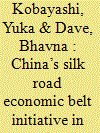| Srl | Item |
| 1 |
ID:
160470


|
|
|
|
|
| Summary/Abstract |
The Silk Road Economic Belt (SREB) initiative, launched by Xi Jinping in 2013 as the Central Asian component of the Eurasian Belt and Road Initiative (BRI), is presented as a trade and infrastructural developmental initiative that benefits all to deliver stability. It consolidates Beijing’s existing economic investments and security-building measures, while launching new projects to link the regions of Central Asia and South Asia more closely with China and extend the arc of security westward and develop these as a transport corridor linking China to Europe. This article examines the interaction between China’s infrastructural investments and security dynamics in the Central Asian region, exploring why the BRI/SREB, presented by China as primarily as a developmental vision, is fraught with wide-ranging security implications. We examine the reception of China’s BRI/SREB in Central Asia focusing on the following three dimensions: (1) the lure of Chinese investments which makes SREB particularly attractive for Central Asian countries; (2) the securitization thrust of the Silk Road initiative which consolidates the power of the Central Asian regimes but also grants considerable role to China in managing security arrangements; (3) elite maneuvering between the lure of Chinese investments and appeasing popular anxieties about China’s growing influence. It points to the overall positive reception in the region to the aid and investment offered by China, while noting the variance in their responses based on the implications of SREB for their sovereignty and security and also concerns on whether the promised benefits of connectivity and development (a “win-win” scenario) will materialize. The article concludes by outlining the implications of China’s rising economic and security engagement in Central Asia and the close Sino-Russian partnership for European financial and security interests and highlights the areas of cooperation and complementarity between China and EU in the region.
|
|
|
|
|
|
|
|
|
|
|
|
|
|
|
|
| 2 |
ID:
185866


|
|
|
|
|
| Summary/Abstract |
This article examines Myanmar's hedging strategies in China's Myanmar Economic Corridor (CMEC), a key component of China's Belt and Road Initiative (BRI). Myanmar has avoided being overly reliant on China by strategically hedging and diversifying its foreign relations with other countries in the region. However, Myanmar's ability to hedge is compromised by its domestic fragmentation, caused by the protracted civil war and rising civil–military tensions. We focus on the two advanced projects in CMEC, the Muse–Mandalay railway and Kyaukphyu deep seaport, and have conducted qualitative, semi-structured interviews with key actors involved in China–Myanmar relations (2016–2021) under the National League for Democracy (NLD). Through the fieldwork findings, we problematize the assumption in the hedging literature which takes for granted a country's competence to act strategically in their foreign policy. Our findings from the Myanmar case suggest that the state's level of fragmentation and capability to hedge are inversely proportional. The multiple actors in Myanmar's political space complicate its China policy and limit its ability to hedge effectively. This is augmented by the military coup in February 2021, which further fragmented the country, compromising Myanmar's China policy even further, making hedging a less viable framework to examine Myanmar's China strategy.
|
|
|
|
|
|
|
|
|
|
|
|
|
|
|
|